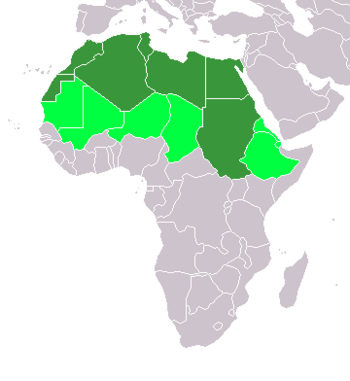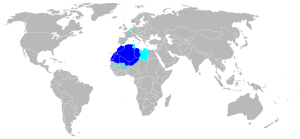Difference between revisions of "Northern Africa" - New World Encyclopedia
(final edit and spell check) |
({{Contracted}}) |
||
| Line 1: | Line 1: | ||
| − | {{Claimed}}{{Images OK}} | + | {{Claimed}}{{Contracted}}{{Images OK}} |
[[Image:LocationNorthernAfrica.png|right|thumb|350px| | [[Image:LocationNorthernAfrica.png|right|thumb|350px| | ||
Revision as of 17:28, 23 July 2007
North Africa or Northern Africa is generally accepted to refer to the northernmost region of the African continent. The political definition of North Africa is highly disputed however, and there is no widely accepted definition of the region or list of countries that fall within the region. For the purposes of this article the United Nations definition of the region will be used. The UN defines North Africa as consisting of:
* The inclusion of Western Sahara in the UN list is highly controversial, as the territory is currently administered by Morocco but is also claimed by the Polisario Front.
Background
Some consider the borders of North Africa as stretching from the Atlantic shores of Morocco in the west to the Suez Canal in the east. While a convenient geographic definition, more often this broad expanse of territory is designated by the term Northern Africa. A more popular political definition of North Africa limits the term to those countries who were formerly known as known Africa under French colonialism. Defining North Africa in this way limits the term to Morocco, Algeria, and Tunisia.
A prominent geographic feature of the region is the Atlas Mountain range, which extends across of Morocco, northern Algeria and parts of Tunisia. The Atlas Mountain Range also served to facilitate agriculture in the region, as most farming takes place in small valleys sheltered from the harsh winds by the mountains. Farming in this manner is also seen in the alcoves created in the Nile Valley and delta and along the Mediterranean coast. Under the sheltered conditions of valley farming a wide variety crops can be grown including: cereals, rice and cotton, and woods such as cedar and cork. Along the coast of the Mediterranean crops such as olives, figs, dates and citrus fruits are also cultivated. Some North African nomads, such as the Bedouin, choose another system of agricultural cultivation and maintain their traditional pastoral lifestyle on the desert fringe. In moving their herds of sheep, goats and camels the Bedouin often cross political borders to find suitable grazing lands.
After defining the landscape in the region, the Atlas Mountain range descends southward and transforms into a steppe landscape before meeting the Sahara. The Atlas mountain range in North Africa is a portion of the fold mountain system that runs throughout parts of Southern Europe.
Culture and Religion
The earliest inhabitants of North Africa were the Berbers, an indigneous group that formed the first civilizations in North Africa in the 5th and 4th century B.C.E. Contact with the Berbers was documented by the Egyptians, Abyssinians (Ethiopians) and Nubians who lived in the northeastern portion of the African continent. While the homelands of these groups are not included under the UN definition of North Africa, must scholars include them when discussing the history of human occupation in the region.
Ethnically, scholars divide North Africa into three regions: The Maghreb, the Nile Valley and the Sahara. The populations of the Maghreb and the Sahara are closely linked through linguistics, as both groups speak dialects that derive from either the berber language or Arabic. While it may seem on first glance that Berber and Arabic are very different languages, they actually exhibit many similarities, as both are members of the Afro-Asiatic language family. Besides a linguistic link between the Maghreb and the Sahara, the populations are also connected along ethnic lines. Ethnic lines are often blurred in the Maghreb, where both the Arabic and the Berber cultures exercise a strong influence on the culture. It is common for a Berber and Arabic speaking individuals in North Africa to identify with the opposite culture of their language due to social and political circumstances. The Berber cultural identity underwent a revival in the 20th century and campaigned to maintain a distinct cultural identity.
While North Africa is predominantly Muslim, a small Jewish population also existed in the region prior to decolonization. When many countries in North Africa gained independence, much of the existing Jewish community emigrated to France. The formation of Israel also contributed to the mass emigration of the North African Jewish population. Today, the Jewish population in North Africa numbers less than fifteen thousand, almost all of which are centered in Morocco and Tunisia.
History
Antiquity and Ancient Rome
Perhaps the most famous civilization to ever form in North Africa was Carthage, a city that entered the annals of history due to long and lengthy battle with Rome. According to myth, Queen Dido was granted land in North Africa to make a civilization for herself and her people, the Phoenicians. The myth states that a local ruler promised Queen Dido all the land that she could cover with a cowhide. Dido was able to devise a clever method of stretching the cowhide, and in that manner gained a large territory for Carthage. The animosity between Carthage and Rome is also traced to myth. Virgil asserts that Dido was rejected by a Trojan Prince called Aenas, and the rejection fell hard on the Phoenicial princess. Aenas would go on to lay the foundation for Rome, but the division between him and his rejected lover was never healed. Eventually the animosity between the two lovers grew to a deep political animosity between Carthage and Rome.
Carthage eventually developed in to a commercial power, but was forced to rely on mercenary soldiers to defend its extensive borders. At the height of its power Carthage reached into Spain and Sicily, a fact which led to the First Punic War with Roman forces. Geographic over expansion taxed the ability of Carthage's navy and left its borders open to military conquest. Roman military forces took advantage of the exposed Carthaginian borders and successed in gained all former Carthaginian lands over a period of 100 years. As a result of Roman incursions into Carthage territory, North Africa was redefined as Roman province of Africa in 146 B.C.E.
The Roman occupation of Northern Africa led to tension and military conflict between Rome and the African civilization at Numidia. The wars with Numidia launched the military careers of many young Romans, including Marius and Sulla. Through repeated military succeses the borders of the Roman Empire expanded and Rome was forced to reevaluate the Roman Constitution. In order to accommodate the needs of Marius, who required a professional army to continue his campaign against Jugurtha. Individual armies were against Roman values and were not previously allowed under Roman law.
North Africa continued under the control of the Roman Empire until the early 5th century. In its heyday it produced such remarkable citizens as Augustus of Hippo. The glory of a Roman North Africa did not last however, and a string of incompetent military leaders left North Africa open to invasion from the Germanic barbarian tribe, the Vandals. In order to breach the Roman defenses the Vandals crossed the straights of Gibraltor and attacked the Roman army along the vulnerable borders.
The invasion by the Vandals let to the loss of all Roman territory in North Africa. In losing the land, the Roman Empire lost a pinnacle and vital feature of the empire, as Roman North Africa had previously been a large exporter of grain. Attempts to regain North Africa were frustrated by repeated Vandal victories. When the Huns launched attacks against the Roman Empire proper, Rome was forced to divert its military forces away from North Africa.
Muslim Invasions
In the early 600s, Arabic Muslims arrived in North Africa and began a campaign to subdue the native North African populations. By 670 the campaign had succeded and most of North Africa had fallen to Muslim rule. In response to the threat of Muslim invasion, the Berbers banded together and began to form their own kingdoms. The Berber kingdoms were successful in establishing themselves and maintained autonomy until the Almoravids launched a successful series of jihads in the 11th century C.E. The jihad movement had the side effect of solidifying the position of Islam in North Africa. Following the success of the jihads, Islam was able to penetrate into sub-Saharan Africa and establish a stronghold.
In the 19th century North Africa was colonized by France, Great Britain, Spain, and Italy. While all four countries had strongholds in North Africa, France controlled the largest portion of North African territory. Following World War Two a nationalistic movement swept across North Africa and all of the North African states gained independence.
Modern Day North Africa
The discovery of oil and natural gas reserves in the desert transformed the economies of Algeria and Libya. Oil rigs now dot the landscape in Libya and Algeria, with Libyan oil being most prized due to its low sulphur content. The economies of North Africa have also revitalized in other areas, for example phosphates has risen to become one of the largest exports in Morocco. Egypt and Tunisia have taken a different approach to economic sustainability, relying on the tourism industry as a vital component of the country's income.
ReferencesISBN links support NWE through referral fees
- Lewis, Brenda Ralph. Great Civilizations. Bath: Parragon Publishing, 1999. ISBN 0752561413
- Costantino, Maria. The Illustrated Flag Handbook. New York: Gramercy Books, 2001. ISBN 0517218100
- Davidson, Basil. West Africa Before the Colonial Era: A history to 1850. Essex: Pearson Education Limited, 1998. ISBN 0582318521
- Encyclopedia Britannica Retrieved July 10, 2007.
External links
- The North Africa Journal Analytical magazine
- Energy and Mining
- Industries and Markets
- Politics and Diplomacy
- Finance and Banking
- Agriculture and Tourism
- Corporate Affairs
- Social and Labor Affairs
- north-of-africa.com news and culture
See also
- European Digital Archive on Soil Maps of the World
- Northern Africa Railroad Development
| Regions of the world | |||||||||||||||||||||||||
|---|---|---|---|---|---|---|---|---|---|---|---|---|---|---|---|---|---|---|---|---|---|---|---|---|---|
|
| ||||||||||||||||||||||||
| See also Continents of the world | |||||||||||||||||||||||||
Credits
New World Encyclopedia writers and editors rewrote and completed the Wikipedia article in accordance with New World Encyclopedia standards. This article abides by terms of the Creative Commons CC-by-sa 3.0 License (CC-by-sa), which may be used and disseminated with proper attribution. Credit is due under the terms of this license that can reference both the New World Encyclopedia contributors and the selfless volunteer contributors of the Wikimedia Foundation. To cite this article click here for a list of acceptable citing formats.The history of earlier contributions by wikipedians is accessible to researchers here:
The history of this article since it was imported to New World Encyclopedia:
Note: Some restrictions may apply to use of individual images which are separately licensed.

